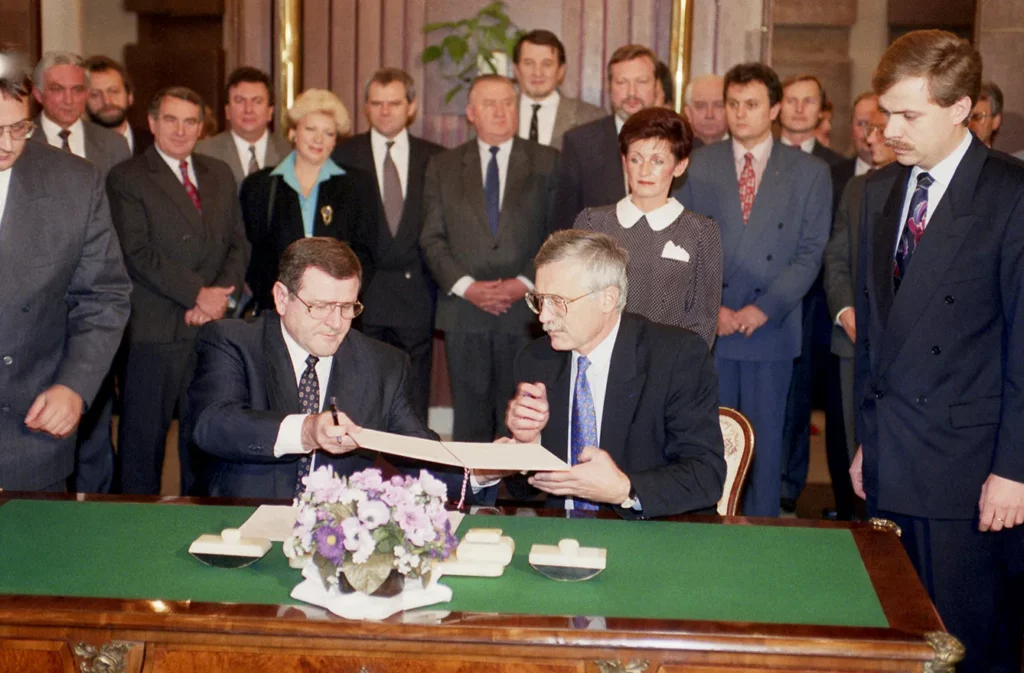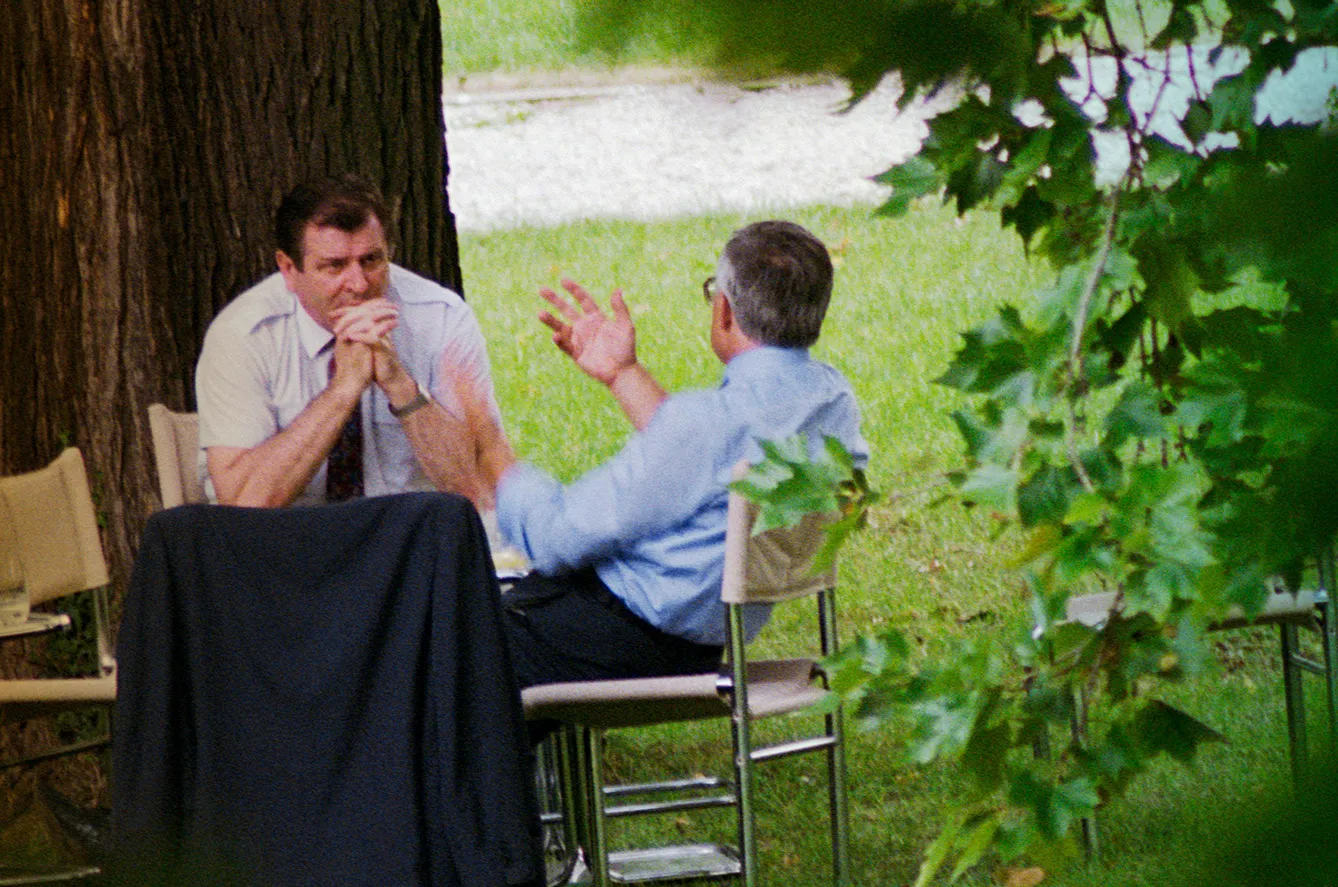It is a rainy fall day at Prague’s Main Railway Station. People are impatiently waiting for the train in jackets and coats while the wind tries to get under their skin. Then an announcement blasts out: “An international express train has arrived on the second track. It continues through Pardubice, Ostrava, and Žilina. The final stop is Košice, Main Railway Station.”
The young people ignore this announcement; they know where they are going. But members of the older generation raise their eyebrows, look at each other and laugh. It happened to me once when I was a kid. I asked my grandmother: “What’s everybody giggling about?” My grandmother replied: “That nonsense about the international express. There’s nothing international about it. It only goes to Slovakia.”
From Czech-Slovak to Czechoslovak
The origins of the so-called “Czech-Slovak ties” do not date back to the beginning of the 20th century. Historically, Bohemia and Slovakia territories were united under one (Jagiellonian) crown as early as 1490. Then again, during the Habsburg rule from 1526 until the independence in the form of the Czechoslovak Republic.
With the First World War still raging in Europe, a group of Czech and Slovak politicians began planning to create a new country: a country that would be free, democratic, and above all, independent of the Austrian monarchy. During those times, Tomas Garigue Masaryk, Czech by mother and Slovak by father, appears on the scene with his controversial concept of Czechoslovakism. Thanks to his, Edvard Beneš‘s, and Jan Rastislav Štefánik‘s efforts, in 1918, US President Woodrow Wilson supported and declared the right to self-determination for the peoples of the Habsburg monarchy. Czechoslovakia can come into being.
Do not be mistaken; Masaryk’s motives were purely pragmatic. Since every third citizen in the historical territory of Czechia was German, the Czechs had little chance of an independent existence. Slovak prospects for the desired autonomy within Hungary were also somewhat unrealistic. So Masaryk came up with the idea of joining the two nations. He was also very adamant. A common state? Yes! But only a unitary republic.
And that’s where the problems that were to cause the break-up of Czechoslovakia began. The Slovaks had always understood the establishment of the Czechoslovak Republic as a union of two equal entities – the Czech lands and Slovakia – while many Czechs saw it as the assertion of their independence with a Slovak “bonus.”
Brothers Forever
After a short period of independence during the Second World War, Slovaks rejoined Czechoslovakia in 1945. They revived the talks of federalization, hoping for more autonomy within the Republic, but president Edvard Beneš rejected Slovak autonomy efforts and returned to the centralism of the First Republic. The Communist Coup of 1948 ended these hopes for good. The Communist government had zero interest in separatist moods within its realm.
During the years of communist dictatorship, the Czechoslovak problems only deepened. The Czechs viewed Slovakia as a backward part of the Republic to which they contributed most of their taxes. And they were not far from the truth. Indeed, the government allocated a large part of the Czechoslovak budget to developing industry and infrastructure in Slovakia. The Slovaks, in turn, criticized the centralist management of the much-differentiated Republic from Prague alone.
The Dash War and the Velvet Divorce
The question of Slovak autonomy reappeared during the Prague Spring at the end of the 1960s. The result? The Czechoslovak Socialist Republic was legally divided into the Czech and Slovak Socialist Republics. However, it was only a cosmetic change, and Prague continued to rule Bratislava, to the displeasure of many Slovaks.
With the victory of democracy after November 1989, the silenced themes of the differences between the two nations reemerged. The seemingly petty Dash War over the country’s name after the deletion of the word “socialist” only illustrates the atmosphere of post-November Czechoslovakia (the Dash War was an effort to change the country’s name to the Czech-Slovak Republic). The compromise with the Czech and Slovak Federative Republic did not satisfy either side.

After the 1992 elections, the Czech Republic and Slovakia’s prime ministers decided to split the Federation peacefully. But something unexpected happened: a wave of opposition arose among the people. It turned out that most people were unwilling to tear apart the fraternal state over petty disputes. But it was too late. On the first of January 1993, two new states were created. The Czech Republic and the Slovak Republic.
Czechoslovakian sobering
Many people actively opposed the partition of the Federation. Tens of thousands demonstrated massively. The wound politicians created in the forced yet peaceful separation has never fully healed. On the 15th anniversary of the dissolution of Czechoslovakia, Radio Prague broadcasted a short poll asking Czechs and Slovaks about the division of the Federation.
The result was clear: most respondents were against the dissolution of the Federation. Many see and saw the split as a betrayal by politicians. The recent 2017 poll confirmed this. People saw the split as a power play by Václav Klaus and Vladimír Mečiar, the then prime ministers of the Czech and Slovak governments. According to many, it was just a division of the political playing field.
Nostalgia for the common country is still present on both sides of the border. Even young people born after 1993 see Czechoslovakia as part of their identity. Many of them, while singing Czech National Anthem, freely continue singing the Slovak one, as people did in the days of the Federation.
Of course, we cannot interpret the results as dissatisfaction with the development of both countries after 1993. On the contrary, people are satisfied. However, many feel that the results would have been much better had the Federation survived. But that is history. The division is still present: many think that the Czechs gained more than the Slovaks from the division of the Federation. The survey also showed another aspect of the two countries’ almost twenty-five years of independence. As time passes, Czechs are less and less interested in what is happening in Slovakia.
Even today, many voices are calling for the reunification of the two countries. In Slovakia and the Czech Republic, roughly half of the population favors such a move. The other half is against it. A realistic view suggests that economic reunification would not be such a problem. This model has always worked, and today, thanks to the European Union, it is still working. But the problem would be the unification of the political scenes.
Ultimately, it is essential to note that the majority don’t see the European Union as a kind of post-federation arrangement of Czechoslovakia. People see the two countries as independent yet still together. Many on both sides of the border say: “We will always be brothers, no matter what happens in the world! With or without the European Union. Czechoslovakia will always survive!”







